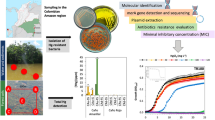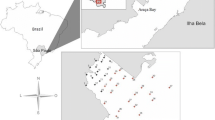Abstract
Although Onondaga Lake in the Syracuse NY area is contaminated with high levels of mercury from past manufacturing operations, macrophytes in the lake have been able to survive, apparently withstanding mercury toxicity. Homogenates of three macrophyte species, Myriophyllum spicatum L., Potamogeton crispus L., and Stuckenia pectinata (L.) Borner, were phenotypically positive for the presence of mercury resistant bacteria. As determined by PCR analysis, the mercury resistant bacteria associated with M. spicatum and S. pectinata also possessed merA, one of the more widely studied essential genes in the mer operon. Analysis of 24 macrophyte taxa isolated from lakes across the United States, as well as biological supply houses, showed that mercury resistant bacteria were associated with all macrophytes. One possible explanation for the association of mercury resistant bacteria with macrophytes is described. This hypothesis suggests that Hgr bacteria may potentially ameliorate the negative effects that mercury elicits in macrophytes.
Similar content being viewed by others
References
Adams, M. S. and Prentki, R. T.: 1982, ‘Biology, metabolism and functions of littoral submersed weedbeds of Lake Wingra, Wisconsin, USA: A summary and review’, Archiv fur Hydrobiologie Suppl.-Bd. 62, 333–409.
Allen, H. L.: 1971, ‘Primary productivity, chemo-organotrophy, and nutritional interactions of epiphytic algae and bacteria on macrophytes in the littoral of a lake’, Ecological Monographs 41, 97–127.
Auer, M. T., Effler, S. W., Storey, M. L., Connors, S. D., Sze, P., Siegfried, C. A., Auer, N. A., Madsen, J. D., Smart, R. M., Eichler, L. W., Boylen, C. W., Sutherland, J. W., Bloomfield, J. A., Wagner, B. A., Danehey, R., Ringler, N. A., Gandino, C., Hirethota, P., Tango, P., Arrigo, M. A., Morgan, C., Millard, C., Murphy, M., Sloan, R. J., Niehaus, S. L. and Whitehead, K. A.: 1996, Chapter 6. ‘Biology’, in S. W. Effler (ed), Limnological and Engineering Analysis of a Polluted Urban Lake, Springer-Verlag, Inc, New York, NY, USA, pp. 384–534.
Barkay, T. and Olson, B. H.: 1986, ‘Phenotypic and genotypic adaptation of aerobic heterotrophic sediment bacterial communities to mercury stress’, Applied and Environmental Microbiology 52, 403–406.
Barkay, T., Miller, S. M. and Summers, A. O.: 2003, ‘Bacterial mercury resistance from atoms to ecosystems’, FEMS Microbiology Reviews 27, 355–384.
Begley, T. P., Walts, A. E. and Walsh, C. T.: 1986, ‘Mechanistic studies of a protonolytic organomercurial cleaving enzyme: Bacterial organomercurial lyase’, Biochemistry 25, 7192–7200.
Bizily, S. P., Rugh, C. L., Summers, A. O. and Meagher, R. B.: 1999, ‘Phytoremediation of methylmercury pollution: merB expression in Arabidopsis thaliana confers resistance to organomercurials’, Proceedings of the National Academy of Science, USA 96, 6808–6813.
Bloom, N. S. and Effler, S. W.: 1990, ‘Seasonal variability in the mercury speciation of Onondaga Lake (New York)’, Water, Air, Soil Pollution 53, 251–265.
Burkholder, J. M. and Wetzel, R. G.: 1989, ‘Microbial colonization on natural and artificial macrophytes in a phosphorus-limited, hardwater Lake’, Journal of Phycology 25, 55–65.
Che, D., Meagher, R. B., Heaton, A. C. P., Lima, A., Rugh, C. L. and Merkle, S. A.: 2003, ‘Expression of mercuric ion reductase in eastern cottonwood (Populus deltoides) confers mercuric ion reduction and resistance’, Plant Biotechnology Journal 1, 311–319.
Delbecque, E. J. P.: 1985, ‘Periphyton on nymphaeids: An evaluation of methods and separation techniques’, Hydrobiologia 124, 85–93.
Environmental Protection Agency: 1994, ‘Method 7470A-Mercury in Liquid Waste (Manual Cold-Vapor Technique)’, retrieved 29 April 2004 from http://www.epa.gov/SW-846/pdfs/7470a.pdf
Effler, S. W. (ed.): 1996, ‘Limnological and engineering analysis of a polluted urban Lake’, Springer-Verlag, Inc, New York, NY, USA, 832 pp.
Effler, S. W. and Harnett, G.: 1996, Chapter 1. ‘Background’, in S. W. Effler (ed), Limnological and engineering analysis of a polluted Urban Lake, Springer-Verlag, Inc, New York, NY, USA, pp. 1–31.
FX Browne Associates, Inc.: 1991, Lake Nockamixon, FXB Project No. 1033-02. FX Brown Associates, Inc. Lansdale, PA, USA, 54 pp.
Hagnere, C. and Harf, C.: 1993, ‘Symbiotic interactions between free-living amoeba and harboured mercury-resistant bacteria’, European Journal of Protistology 29, 155–159.
Heaton, A. C. P., Rugh, C. L., Kim, T., Wang, N. J. and Meagher, R. B.: 2003, ‘Toward detoxifying mercury-polluted aquatic sediments with rice genetically engineered for mercury resistance’, Environmental Toxicology and Chemistry 22, 2940–2947.
Jana, S.: 1988, ‘Accumulation of Hg and Cr by three aquatic species and subsequent changes in several physiological and biochemical plant parameters’, Water, Air, and Soil Pollution 38, 105–109.
Liebert, C. A., Wireman, J., Smith, T. and Summers, A. O.: 1997, ‘Phylogeny of mercury resistance (mer) operons of gram-negative bacteria isolated from the fecal flora of primates’, Applied and Environmental Microbiology 63, 1066–1076.
Madsen, J. D., Bloomfield, J. A., Sutherland, J. W., Eichler, L. W. and Boylen, C. W.: 1996, ‘The aquatic macrophyte community of Onondaga Lake: Field survey and plant growth bioasays of lake sediments’, Lake and Reservoir Management 12, 73–79.
Madsen, J. D., Smart, R. M., Eichler, L. W., Boylen, C. W., Sutherland, J. W. and Bloomfield, J. A.: 1993, ‘Submersed littoral vegetation distribution: Field quantification and experimental analysis of sediment types from Onondaga Lake, New York’, Technical Report A-93-14, U. S. Army engineer waterways experiment station, Vicksburg, MS, USA, 60 pp.
Mhatre, G. N. and Chapehekar, S. B.: 1985, ‘The effect of mercury on some aquatic plants’, Environmental Pollution (Series A) 39, 207–216.
Osborn, A. M., Bruce, K. D., Strike, P. and Ritchie, D. A.: 1995, ‘Sequence conservation between regulatory mercury resistance genes in bacteria from mercury polluted and pristine environment’, Systematic and Applied Microbiology 18, 1–6.
Parniske, M.: 2000, ‘Intracellular accommodation of microbes by plants: A common developmental program for symbiosis and disease?’, Current Opinion in Plant Biology 3, 320–328.
Rugh, C. L., Wilde, D. H., Stack, N. M., Thompson, D. M., Summers, A. O. and Meagher, R. B.: 1996, ‘Mercuric ion reduction and resistance in transgenic Arabidopsis thaliana plants expressing a modified bacterial merA Gene’, Proceedings of the National Academy of Science, USA 93, 3182–3187.
Sadhukhan, P. C., Ghosh, S., Chaudhuri, J., Ghosh, D. K. and Manal, A.: 1997, ‘Mercury and organomercurial resistance in bacteria isolated from freshwater fish of wetland fisheries around Calcutta’, Environmental Pollution 97, 71–78.
Salt, D. E., Smith, R. D. and Raskin, I.: 1998, ‘Phytoremediation’, Annual Review of Plant Physiology and Plant Molecular Biology 49, 643–668.
Stiling, P. D.: 2002, Ecology: Theories and Applications, 4th Edition, Prentice-Hall, Inc., Upper Saddle River, NJ, USA, 403 pp.
Ulanoski, J. T., Shertzer, R. H., Baker, J. L. and Hartman, R. T.: 1981, ‘Trophic classification and characteristics of twenty-six publicly owned Pennsylvania Lakes’, Publication No. 61, Bureau of Water Quality Management, Pennsylvania Department of Environmental Resources, Harrisburg, Pennsylvania, USA, 240 pp.
Wang, W. and Driscoll, C. T.: 1995, ‘Patterns of total mercury concentrations in Onondaga Lake, New York’, Environmental Science and Technology 29, 2261–2266.
Wetzel, R. G.: 2001, Limnology: Lake and River Ecosystems, 3rd Edition, Academic Press, San Diego, CA, USA, 1006 pp.
Author information
Authors and Affiliations
Corresponding author
Rights and permissions
About this article
Cite this article
Caslake, L.F., Harris, S.S., Williams, C. et al. Mercury-Resistant Bacteria Associated With Macrophytes from A Polluted Lake. Water Air Soil Pollut 174, 93–105 (2006). https://doi.org/10.1007/s11270-005-9040-7
Received:
Accepted:
Published:
Issue Date:
DOI: https://doi.org/10.1007/s11270-005-9040-7




